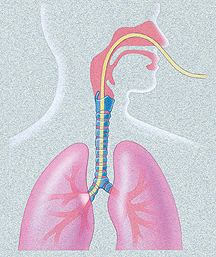Diagnosing and Staging Lung Cancer
If your doctor thinks you may have lung cancer, he or she will most likely order a number of tests. No single test diagnoses lung cancer. But together, these tests do more than diagnose the disease. They can reveal the type of cancer, where it's located, and if, or how much, it has spread. Test results may also help your doctor plan treatment.
What Do the Tests Show?
Each test result for lung cancer offers a new piece of information. Taken as a whole, the results reveal precise details about your cancer and how advanced it is. For instance, do you have non-small-cell or small-cell lung cancer? How large is the tumor? Where is the tumor located? Are the lymph nodes involved? Has the cancer spread? With these details, you and your doctor can start to plan treatment.

A bronchoscope provides a direct view of the windpipe and bronchial tubes.
Biopsy
In a biopsy, a small sample of tissue is removed. It can be taken from a tumor in the lung or from other parts of your body. That sample is then studied under a microscope to learn more about your cancer. The following tests can be done to obtain a biopsy.
-
During bronchoscopy, a thin, lighted, flexible tube goes into the nose and down the windpipe. The doctor then has a direct view of the windpipe and bronchial tubes. Tissue samples may be taken. The walls of the windpipe may also be brushed and rinsed. This loosens cells. The cells can then be removed and studied in a lab.
-
In a fine-needle aspiration (FNA), a very thin needle is used to remove cells from a tumor. This test is done under local anesthesia to help prevent pain. During the FNA, you may have a CT scan. This helps the doctor position the needle exactly where it needs to be.
Imaging Tests
Pictures from different imaging tests can provide details about your lungs and any tumors they may have. These pictures can also show a tumor's location and size. A chest x-ray is one of the most common imaging tests. Other imaging tests will likely be done. A CTscan is a computer-enhanced x-ray image. A PET scan (positron emission tomography) uses a safe radioactive liquid (tracer) to find areas where cancer cells are in the body. The test also helps determine how fast the cells are growing. A PET scan is often done along with a CT scan. It can detect a tumor that may not appear on a chest x-ray. Less often, an MRI may be done. This test uses strong magnets and computers to help form a highly detailed image. You may also have a bone scan or other imaging tests to learn whether the cancer has spread. Your doctor will tell you how to prepare for any tests.
Staging of Lung Cancer
Staging is a process to measure how advanced the cancer is. Stage 1 is the least advanced. Stage 4 is the most advanced. The following three factors are considered:
-
The tumor. How large is it?
-
The lymph nodes. Have they been affected?
-
Metastasis. Has the cancer spread?












